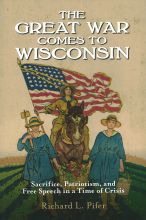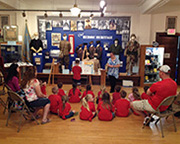
|
News at MCLHR
April 25 History Program: "Shop Talk: History & Memories of the Milwaukee Road Shops in Tomah" The Monroe County Local History Room & Museum presents: “Shop Talk: History & Memories of the Milwaukee Road Shops in Tomah,” a public program to be held on Thursday, April 25th at 7pm at the Sparta United Methodist Church... Click here for more
History Room closed Jan. 16-22. Reopens Jan. 23.
|
Monroe County ABCsTitle: Monroe County ABCs
Goals:
Language Development and Communication Performance Standards Related to the Program A.EL.1 Derives meaning through listening to communications of others and sounds in the environment. A.EL.2 Listens and responds to communications with others. A.EL.3 Follows directions of increasing complexity. B.EL.1 Uses gestures and movements (non-verbal) to communicate. B.EL.2a-2c Uses vocalizations and spoken language to communicate. Language Form, Language Context, and Language Function C.EL.1 Develops ability to detect, manipulate, or analyze the auditory parts of spoken language. C.EL.2 Understands concept that the alphabet represents the sounds of spoken language and the letters of written language. C.EL.3 Shows appreciation of books and understands how print works. Approaches to Learning Performance Standards Related to the Program B.EL.1 Engages in imaginative play and inventive thinking through interactions with people, materials, and the environment. C.EL.2 Learns within the context of his/her family and culture. C.EL.3 Uses various styles of learning including verbal/linguistic, bodily/kinesthetic, visual/spatial, interpersonal, and intrapersonal
Wisconsin Model Academic Standards A.4.7 Identify connections between the local community and other places in Wisconsin, the United States, and the world B.4.4 Compare and contrast changes in contemporary life with life in the past by looking at social, economic, political, and cultural roles played by individuals and groups B.4.7 Identify and describe important events and famous people in Wisconsin and United States history B.4.10 Explain the history, culture, tribal sovereignty, and current status of the American Indian tribes and bands in Wisconsin D.4.3 Identify local goods and services that are part of the global economy and explain their use in Wisconsin E.4.5 Identify and describe institutions such as school, church, police, and family and describe their contributions to the well being of the community, state, nation, and global society E.4.12 Give examples of important contributions made by Wisconsin citizens, United States citizens, and world citizens 5:2:B8 Regularly encourages others and refrains from negative statements.
Common Core State Standards for Literacy in All Subjects (K-5) Related to the Program RI.1.6 Distinguish between information provided by pictures or other illustrations and information provided by the words in a text. RI.1.7 Use the illustrations and details in a text to describe its key ideas SL.1.1a Follow agreed-upon rules for discussions (e.g., listening to others with care, speaking one at a time about the topics and texts under discussion). SL.1.1c Ask questions to clear up any confusion about the topics and texts under discussion. SL1.3 Ask and answer questions about what a speaker says in order to gather additional information or clarify something that is not understood
Click HERE to book your school group at LHR or to ask a question
|
||
200 W. Main St., Sparta, WI 54656 | Phone: (608) 269-8680 | Email: MCLHR@centurytel.net | Visit Us On Facebook
Website development by Webteam, Inc.

